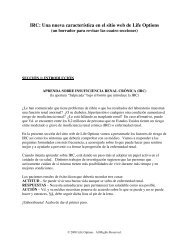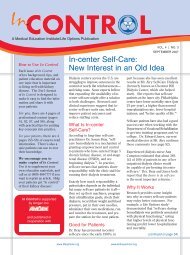Just the Facts: Vascular Access - Life Options
Just the Facts: Vascular Access - Life Options
Just the Facts: Vascular Access - Life Options
You also want an ePaper? Increase the reach of your titles
YUMPU automatically turns print PDFs into web optimized ePapers that Google loves.
<strong>Just</strong> <strong>the</strong> <strong>Facts</strong>: <strong>Vascular</strong> <strong>Access</strong><br />
What is a vascular access<br />
A vascular access is a way to reach <strong>the</strong><br />
blood vessels for hemodialysis. There are<br />
three types:<br />
A fistula is your artery and vein sewed<br />
toge<strong>the</strong>r. Blood from <strong>the</strong> artery makes <strong>the</strong><br />
vein thicker so it can be used for dialysis.<br />
A fistula is often <strong>the</strong> longest-lasting access.<br />
A graft is a piece of man-made blood<br />
vessel. It is used to connect an artery and<br />
a vein toge<strong>the</strong>r.<br />
Graft<br />
Illustration from Core Curriculum for <strong>the</strong> Dialysis Technician, 1998<br />
Fistula<br />
Vein<br />
Artery<br />
Artery<br />
Vein<br />
A ca<strong>the</strong>ter is a plastic tube placed into a<br />
vein in <strong>the</strong> neck, chest, or groin. Ca<strong>the</strong>ters<br />
may be used for a short time while a fistula<br />
or graft is healing. In some patients with<br />
very poor veins and arteries, a permanent<br />
ca<strong>the</strong>ter may be placed in <strong>the</strong> chest.<br />
Why is a vascular access important to<br />
me<br />
Your access is your dialysis lifeline. You<br />
have only a few sites for vascular access.<br />
It is important to care for your access so it<br />
will last as long as possible.<br />
What happens in access surgery<br />
A fistula or graft is most often placed in an<br />
arm, but sometimes in a leg. Your doctor<br />
will decide which type of access will work<br />
best for you. Ask your doctor if a fistula<br />
will work for you.<br />
Surgery for a fistula or graft is often done<br />
with local anes<strong>the</strong>sia on an outpatient basis.<br />
Medication may be needed for mild to<br />
moderate pain. Sometimes swelling of <strong>the</strong><br />
arm may occur for a few days or weeks.<br />
When can my access be used<br />
It is best to create an access before it is<br />
needed for dialysis. If a new access is used<br />
too soon after surgery, it can be damaged.<br />
A new fistula should ideally not be used for<br />
3 to 4 months after surgery. A new graft<br />
should not be used for 3 to 6 weeks.<br />
What should I do after surgery<br />
Exercise that brings more blood flow to <strong>the</strong><br />
arm can help a fistula to work better.<br />
Squeezing a rubber ball many times a day<br />
can help <strong>the</strong> fistula mature, or become<br />
ready to use.<br />
March 2005
How can I keep my access working<br />
Problem How can I prevent it What should I ask<br />
I want to • Keep your access clean. • How should I clean my access<br />
avoid infection. • Be sure your access is washed • Do I need to cover my access<br />
with antibacterial soap and in <strong>the</strong> bathtub or shower<br />
iodine or alcohol before it is • Can I swim in a pool or a lake<br />
used for dialysis.<br />
• Who should I call if I have an<br />
• Tell <strong>the</strong> nurse if your access is access problem<br />
warm, red, has pus, or you have<br />
a fever.<br />
I want to • Learn how to feel <strong>the</strong> thrill • Can my doctor or nurse tell<br />
avoid blockage. (vibration) and listen for <strong>the</strong> that my access is not working<br />
bruit (buzzing) in your access. well How do <strong>the</strong>y know<br />
Tell <strong>the</strong> nurse if <strong>the</strong> thrill or • If my access is blocked, can<br />
bruit changes.<br />
it be fixed How<br />
• Tell <strong>the</strong> nurse if your hand is<br />
cold, blue, numb, painful, or<br />
hard to move.<br />
I don’t want • Learn how needle sites are • What is <strong>the</strong> needle rotation<br />
to injure my rotated on your access. Be sure pattern for my access<br />
access. <strong>the</strong> right site is used at each • How much weight can I carry<br />
treatment.<br />
safely after surgery When<br />
• Do not carry heavy weights can I carry more<br />
across <strong>the</strong> access.<br />
• Can I wear a watch or hang a<br />
• Avoid pressure on <strong>the</strong> access purse over my access arm<br />
during sleep.<br />
• How can I avoid sleeping on<br />
• Avoid tight clothing.<br />
my access arm<br />
• Do not allow blood pressure<br />
or blood draws from this arm.<br />
Where can I get more information about vascular access<br />
• Visit Kidney School Module 8: <strong>Vascular</strong> <strong>Access</strong>: A <strong>Life</strong>line for Dialysis at<br />
www.kidneyschool.org.<br />
• Focus on Fistulas/Your <strong>Access</strong>: A Choice for a Better <strong>Life</strong>, In Control Vol. 1 #1,<br />
March 2004. For a free copy go to www.lifeoptions.org.<br />
• Understanding your hemodialysis acces options. To request a free<br />
copy, call <strong>the</strong> American Association of Kidney Patients (AAKP) at (800) 749-AAKP<br />
or visit <strong>the</strong>ir website at www.aakp.org.<br />
<strong>Life</strong> <strong>Options</strong> Rehabilitation Program<br />
414 D’Onofrio Drive, Ste. 200, Madison, WI 53719 • (800) 468-7777<br />
www.lifeoptions.org • lifeoptions@meiresearch.org<br />
Supported by Amgen Inc.















